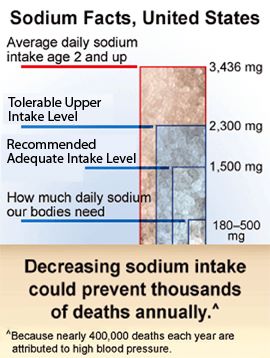
Americans Consume Too Much Sodium (Salt)
Sodium intake from processed and restaurant foods contributes to increased rates of high blood pressure, heart attack, and stroke. Decreasing sodium intake to within recommended limits could prevent thousands of deaths annually.

Chart: Average daily sodium intake age 2 and up: 3,436 mg. Tolerable upper intake level: 2,300 mg. Recommended adequate intake level: 1,500 mg. How much daily sodium our bodies need: 180-500. Decreasing sodium intake could prevent thousands of deaths annually, because nearly 400,000 deaths each year are attributed to high blood pressure.Americans eat too much sodium, commonly consumed as salt. High sodium consumption raises blood pressure. High blood pressure is a major risk factor for heart disease and stroke, the nation's first and third leading causes of death, respectively.
Research shows a dose-dependent relationship between consuming too much salt and elevated blood pressure. When salt intake is reduced, blood pressure begins decreasing for most people within a few days to weeks. Populations who consume diets low in salt do not experience the increase in blood pressure with age that is seen in most Western countries.
Sodium Consumption and the American Food Supply
We all need a small amount (e.g., between about 180 mg and 500 mg per day) of sodium to keep our bodies working properly.
The Institute of Medicine recommends 1500 mg of sodium per day as the Adequate Intake level for most Americans and advises everyone to limit sodium intake to less than 2300 mg per day, the Tolerable Upper Limit. The 2005 Dietary Guidelines for Americans considered the IOM recommendations and advise limiting sodium to less than 2300 mg per day (about 1 tsp of table salt) for the general population and 1500 mg per day for special population groups. 2010 Dietary Guidelines for Americans will be released soon.
* The Adequate Intake (AI) of 1500 mg per day is the recommended average daily sodium intake level. The IOM set the AI for sodium for adults at 1500 mg per day to ensure that the overall diet provides sufficient amounts of other nutrients and to cover sodium sweat losses in physically active individuals.
* The Upper Limit (UL) of 2300 mg per day refers to the highest daily level of sodium that is likely to pose no risk of adverse health effects to almost all individuals in the general population. The UL is not a recommended intake and there is no apparent benefit to consuming levels of sodium above the Adequate Intake (AI).
* The average daily sodium intake for Americans age 2 years and older is 3,436 mg.
* Since the 1970s, the amount of sodium in our food has increased, and we are eating more food each day than in the past.
* The vast majority of the sodium consumed is from processed and restaurant foods; only a small portion is used in cooking or added at the table.
Even if a person does not have high blood pressure they may still benefit from reducing the amount of sodium in their diet because the lower one's blood pressure in general, the lower the risk of heart disease and stroke. If manufacturers gradually reduced the amount of sodium in processed and prepared foods, the major sources of sodium in the food supply, public consumption of sodium could be reduced to safer levels with little or no individual behavior changes needed on the part of the consumer. Gradual reductions of sodium would also easily allow for taste adaptations in response to reduced sodium. Sodium intake from processed and restaurant foods contributes to high rates of high blood pressure, heart attack, and stroke. Because nearly 400,000 deaths each year are attributed to high blood pressure, decreasing sodium intake could prevent thousands of deaths annually. Other benefits of reduced sodium intake are reduced risk of gastro-esophageal cancer, reduced left ventricular (heart) mass and preserved bone mass.
Data Sources:
Centers for Disease Control and Prevention, National Center for Chronic Disease Prevention and Health Promotion. Sodium Fact Sheet. Adobe PDF file [PDF - 308KB - Sodium_Fact_Sheet.pdf (Objeto application/pdf)] November 2009.
U.S. Department of Health and Human Services, U.S. Department of Agriculture. Dietary guidelines for Americans 2005. Washington, DC: Government Publishing Office, 2005.
Institute of Medicine. (2005) Dietary reference intakes for water, potassium, sodium chloride, and sulfate. 1st ed. Washington, DC: The National Academies Press.
Institute of Medicine. (2010) Strategies to Reduce Sodium Intake in the United States. Washington, DC: The National Academies Press.
More Information
* Sodium: CDC - DHDSP - Salt Home
* High Blood Pressure and Sodium: CDC - DHDSP - High Blood Pressure and Sodium
* Stroke: CDC - DHDSP - Stroke Home
* Heart Disease: CDC - DHDSP - Heart Disease Home
* Feature: American Heart Month: CDC Features - February is American Heart Month
* Too Much Salt Can Be Risky [PODCAST - 0:30 second] CDC - CDC Radio
CDC Data & Statistics | Feature: Americans Consume Too Much Sodium (Salt)
































No hay comentarios:
Publicar un comentario